An iconographic and text archive related to communication, technology and art.
On this occasion, whilst illustrating Kant’s notions of the animal economy, it may be as well to add one other particular, which is, that for fear of obstructing the circulation of the blood, he never would wear garters; yet, as he found it difficult to keep up his stockings without them, he had invented for himself a most elaborate substitute, which I shall describe. In a little pocket, somewhat smaller than a watch-pocket, but occupying pretty nearly the same situation as a watch-pocket on each thigh, there was placed a small box, something like a watch-case, but smaller; into this box was introduced a watch-spring in a wheel, round about which wheel was wound an elastic cord, for regulating the force of which there was a separate contrivance. To the two ends of this cord were attached hooks, which hooks were carried through a small aperture in the pockets, and so passing down the inner and the outer side of the thigh, caught hold of two loops which were fixed on the off side and the near side of each stocking. As might be expected, so complex an apparatus was liable, like the Ptolemaic system of the heavens, to occasional derangements; however, by good luck, I was able to apply an easy remedy to these disorders which sometimes threatened to disturb the comfort, and even the serenity, of the great man.
☛ Blackwood’s Magazine: “The Last Days of Kant” by Thomas De Quincey, No. 122, Vol. 21, February 1827, p. 139; reprinted in Last Days of Immanuel Kant; and Other Writings, De Quincey’s Work Vol. III, Edinburgh: Adam & Charles Black, [1871] 1862, p. 119.
As he aknowledges himself, De Quincey’s work is a liberal adaptation of Ehregott Andreas Wasianski’s account of Kant’s life, first published in German, in 1804: Immanuel Kant in seinen letzten lebensjahren. In Blackwood’s Magazine, De Quincey’s essay is subtitled with the mention: “From the German of Wasianski, Jachmann, Borowski, and Others”. In the version printed in 1871, De Quinzey’s introduction ends with this observation: “Now let us begin, premising that for the most part it is Wasianski who speaks.” (p. 105). This observation however is accompanied by a long footnote opening up an interesting discussion about De Quincey’s translation and about the liberties he took while creating his own interpretation of Kant’s life.
In his biography of the German philosopher, Manfred Kuehn provides the following account of the role played by Wasianski in Kant’s late life:
Wasianski was a deacon who had taken care of Kant during his final years. He had studied at the University of Königsberg between 1772 and 1780. Indeed, like Jachmann, he had also been Kant’s amanuensis. He could have said much about Kant’s life during the seventies, but strangely enough he says nothing about these years, restricting himself to an account of Kant’s last year. After Wasianki left the university in 1780, he had no contact with Kant for a decade, meeting him again only in 1790 at the wedding reception. Kant seems to have invited him immediately to his regular dinner parties, and gradually come to rely on him. Over the years he entrusted him with more and more of his personal business. Indeed, Wasianki ultimately earned Kant’s complete trust. Having been chosen by Kant as his personal secretary and helper, as well as the executor of his will, he knew the aged Kant’s circumstances very well. (Kant: A Biography, Cambridge: Cambridge University Press, 2001, p. 7)
• • •
De Quinzey’s essay was translated by Marcel Schwob into French in 1899 and published in an issue of Vogue (April 4th). The translation was reprinted in 1927, among a collection of other essays Schwob wrote in his youth: Écrits de jeunesse de Marcel Schwob (Paris: François Bernouard). Interestingly enough, when it appears in 1899, the French translation was preceded by a short “preface” where the authenticity and authorship of De Quincey’s essay is further discussed:
Ce journal des derniers moments de Kant est composé au moyen des détails que de Quincey tira des mémoires de Wasianski, de Borowski, et de Jachmann, publiés à Kœnigsberg en 1804, année où Kant mourut ; mais il employa aussi d’autres sources. Tout cela est fictivement groupé dans un seul récit, attribué à Wasianski. En réalité l’œuvre est uniquement, ligne à ligne, l’œuvre de Quincey : par un artifice admirable, et consacré par de Foë [Daniel Defoe] dans son immortel Journal de la Peste de Londres, de Quincey s’est révélé, lui aussi, “faussaire de la nature”, et a scellé son invention du sceau contrefait de la réalité.
In 1927, when Marcel Schwob’s translation was republished, the anecdote regarding Kant’s problem with garters must have been picked up by reviewers in various French newspapers. In its edition of December 29, 1927, The Pittsburgh Press claims to borrow the anecdote from an edition of Le Petit Journal. The very short news dispatch is titled “Kant Invented Garter, Says French Journal”, and it reads as follow:
Paris, Dec, 29. – Immanuel Kant, the great and recondite German philosopher, was the inventor of garters, according to the Paris newspaper, Le Petit Journal.
Kant wore long silk stockings with knee breeches and was not long in discovering that the cord which held them in place was dangerous for the circulation of the blood. So he set to work and, between weighty philosophic tomes, invented the modern garter. (p. 7)

- By Philippe Theophanidis
- on
- ― Published in Technology
- Tagged: De Quincey, fashion, invention, Kant, philosophy
